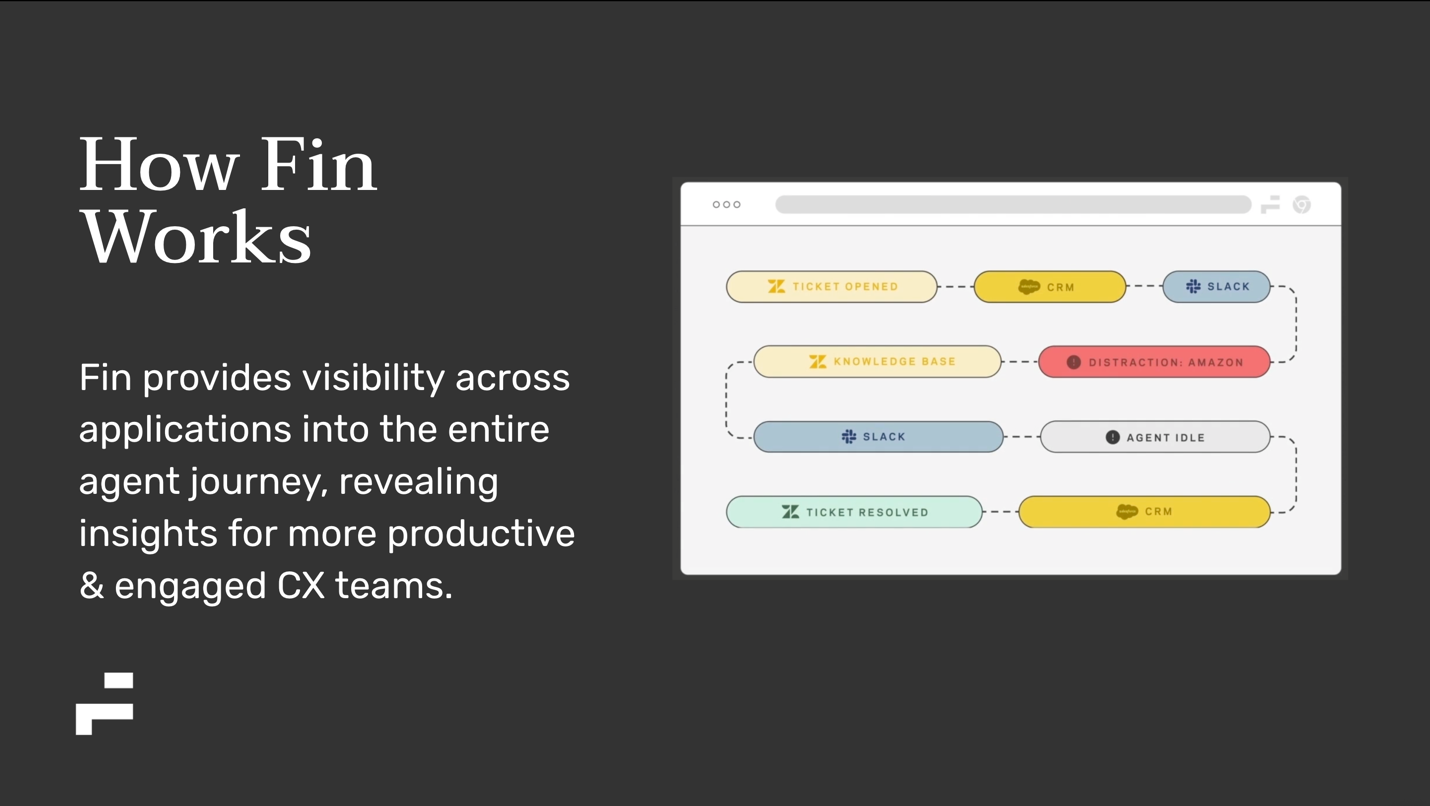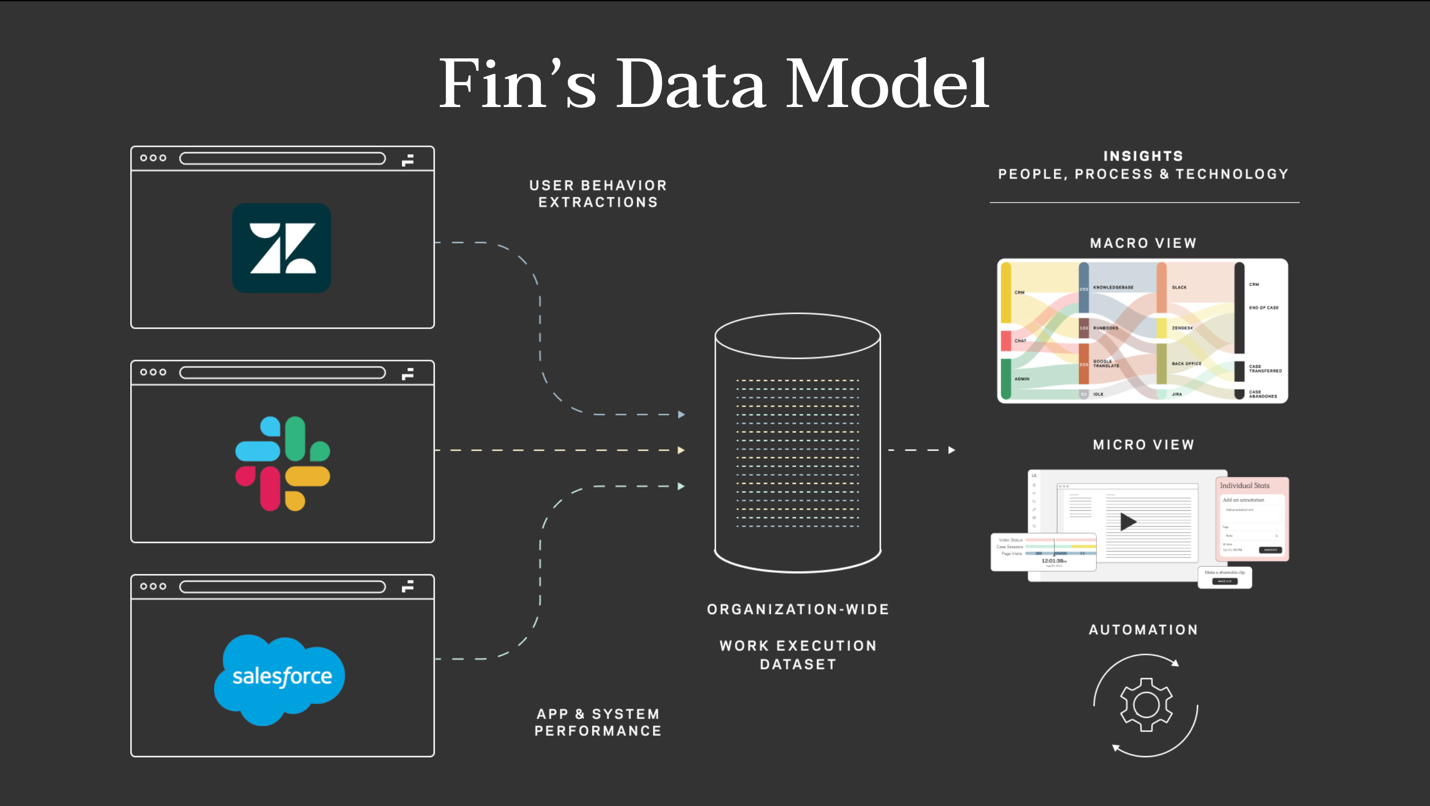Home > Columns > Executive Interviews
Fin Executive Interview

Charlene Wang, VP, Head of Marketing, Fin
Click the image below to view the Flipbook

Sheri Greenhaus, Managing Partner of CrmXchange, recently
had a conversation with Charlene Wang, VP, Head of Marketing, Fin (Fin.com) to
discuss Fin’s solution for enabling more productive and effective CX
teams. You can visit FIN at CCW, booth #220
Tell us about Fin.
Fin is a Work Insights Platform. We empower companies to
achieve better CX outcomes by providing comprehensive visibility into the agent
journey, surfacing insights that improve agent and customer experiences.
Fin instantly pulls in data across all browser applications
to paint an end-to-end picture of what the agent journey looks like. This
uncovers insights, beyond just the CRM or ticketing system, into how time is
actually spent, the “golden path” for optimal outcomes, and specific ways to
improve coaching, processes, and technology.

How did Fin start?
Fin started as an internal tool. The original founders of
Fin were the first VP of Product from Facebook and the Co-Founder of Venmo.
They created a virtual AI assistant. They ended up with a huge support
team of hundreds of people across sites around the country to help manage the
requests from customer issues and challenges. It quickly became a management
issue.
They needed to understand what was happening with the team,
how to retain and enable the team to be better, and how to drive more
operational efficiency amidst changing customer and agent needs.
The founders’ key insight was that agents were primarily
using SaaS applications. All of the work was happening within the browser. With
a simple browser plugin, we were able to access almost all the data on agent
behavior across applications. We then structured the data to reveal the story
of an agent’s day-to-day experience. We looked at how to optimize processes. We
looked at the handle time spent on different types of tickets, knowledge bases
that are working, missing knowledge articles, how internet load speeds on
frequently used pages impacted outcomes, and even where to make agent coaching
better, based on what we observed actually working, not just our best guess of
what works.
With this knowledge, we personalized coaching, adjusted
processes, and improved our technology stack. We looked at the metrics around
how tickets are resolved to find the best way to handle those types of tickets.
From there, we were able to look at how the best responses could be replicated
for other agents.
What data are you looking at? Are you looking at agent data,
ticket data, etc.?
All of that data. We organize workflows by tickets, but we
know the agent, we know the customer, the types of tickets. We take any
activity in the browser and extract that data to understand what is happening.
We can layer in things like NPS scores as well as what kind of tickets resulted
in what handle times, reopened ticket rates, even whether agents end up staying
at the company or leaving, and more. Most of this data is available
out-of-the-box on day one. All this data is tied together to paint a complete
picture of the agent experience.
If I am a customer starting on the web, progressing to a
call, does Fin see and understand that?
Yes, as long as a record of the activity exists in a system
of record in a SaaS application, we can provide insights into what’s happening.
One of the metrics we look at quite a lot is ticket reopens (alternatively, we
look at first time resolution) which gives us insights into the effectiveness
of a resolution, no matter which channels the initial and follow up activities
happen in.
Are you a data analytics company? Do you help with
automation?
We are an analytics or data insights company, and we also
enable many other types of solutions, such as automation or RPA solutions. Many
companies want to automate parts of the agent journey, but the problem is that
it’s hard to understand the real customer journey. What underpins all of that is
the ability to identify where automation would best serve the organization.
Often, companies have an idea of where things can break down, but don’t
actually know where the real breakdowns happen and what the most repeatable
processes are. Having the data to back up the hypothesis of what needs to
be automated is helpful and necessary.
Another thing that we enable companies to do is A/B test how
operational changes impact actual outcome metrics. For example, if I am
not sure that a change in my knowledge base will impact resolution time for a
ticket, I can test it and do a side-by-side comparison. This A/B testing
can also be applied to any RPA solutions that a company introduces. This
helps to both identify the impact of a process or technology change on outcomes
and make a more ROI-based business case for people, development resources, etc.

Let’s dig deeper into how to assist with coaching agents.
For coaching and training we first look at what is actually
working – who is doing a good job, what are some of the behaviors that drive a
good outcome? We have a dashboard of process metrics that helps guide what SOPs
should look like, where there are opportunities for more QA, and what steps are
agents doing that need to be adjusted.
The next area is technology. For example, Airbnb has a
product team that builds applications to enable their associates and contact
centers. They use Fin to understand if their associates are using the
applications that they’ve built and if it’s helping impact the
metrics.
We identify bottlenecks that are frustrating agents. We
found in one case for one of our customers, agents were doing large amounts of
copy and paste due to a bad SOP – this was a huge waste of time. In one
instance a company’s agents were taking customer data and documents and pasting
it into Google translate. This was introducing risks to the business. Because
of Fin, they were able to identify the problem and figure out better ways to
enable their agents to avoid this kind of behavior.
You mentioned that you can help with the reduction of agent
churn.
We've helped some of our companies predict when agents are
about to churn based on behavioral data. One company had their HR database set
up, and we were able to tie that data to the data in Fin and see that the risk
factors for churn included behaviors like when agents stopped engaging with the
CRM, if they were spending time on Facebook, etc. All these factors
together let us build a data-driven profile of agents who have a greater chance
of leaving the company. Based on that, we were able to identify teams at higher
risk of churn and some of the factors that can be rectified.
We’ve found that some of the top reasons why agents choose
to leave are poor enablement and burnout. As the Great Resignation continues,
companies can’t afford to lose their best employees. We try to identify how to
make the agent experience better and less frustrating overall and help
companies target the specific teams that data suggest have the greatest risk of
turnover.
Many teams are now remote. Does looking at the data
help manage the agents?
Yes, we help manage remote teams by providing objective,
data-based ways for companies to understand remote agents, manage the entire
team towards better outcomes, and create better experiences. When the pandemic
started, Coinbase suddenly sent all of their agents home and struggled to
understand the experience of these newly remote agents. Coinbase has been using
Fin to gain visibility into what their remote agents need and how to enable
their success, especially as the team has grown rapidly in the last couple of
years.
For companies who request it, we also offer screen
recording. For some managers, no longer being in the office means that they
can’t see what their agents are dealing with. We’ve had companies use the
screen recording feature in lieu of “walking the floor” as they would have when
agents worked onsite. In many cases they use these screen recordings as
training videos – to show an improved way to do a task that one agent has
discovered and that others should emulate.
Finally, for some companies in highly regulated spaces, they
have strict requirements around data privacy, auditing, and compliance. In some
cases, they need to see if agents are copy and pasting sensitive data. If there
is a lot of copy and paste, they want to identify what drove agents to do this
action. Fin helps companies identify potential sources of data privacy risks
and implement procedures to ensure that companies stay compliant.
How do you help with capacity planning?
We give a level of insight that provides a highly granular
ability to predict exactly how many agents (or how much BPO capacity) is
needed, especially given changing needs from customers and the business.
Some companies struggle with how much time it takes for
agents to work with certain types of tickets. By helping understand the exact
handle times spent on specific types of tasks and how much inefficiency can
realistically be reduced, we help identify precisely how many agents are needed
to support a company’s specific requirements.
During the pandemic, many of our ecommerce customers
suddenly and unexpectedly saw their businesses double or even triple overnight.
They needed a better handle on how much resources they required to support
these new customers. Using Fin, these companies were able to precisely forecast
the number of agents needed. Additionally, without enough resources to staff up
immediately, they were able to find creative ways to enable the existing team
to handle the spike in demand through automation, training, better knowledge
base articles, etc. This would not have been possible without the level of
insights that Fin gave into the exact ways in which agent capacity was being
used and the top capacity bottlenecks.
Are the reports and insights from Fin available out-of-the-box?
We built Fin to be extremely easy to install. Most customers
only need their team to download the browser plugin, and with minimal setup,
Fin immediately starts collecting data, which is then structured into
out-of-the-box reports.
We have many out-of-the-box dashboards of common pain points
and common metrics. These dashboards were created from our firsthand experience
building and growing a large support team and the kinds of insights that we
needed. We’ve also continued to refine and improve our out-of-the-box reporting
based on the needs of our customers. From the feedback of customers, we’ve
developed a variety of solutions-based dashboards that help with everything
from capacity planning, technology monitoring, agent coaching, BPO management,
etc. All of our out-of-the-box dashboards are available immediately and do not
require any custom configuration.
For those who have more advanced requirements, the product
is extremely configurable so that you can do what you want with the data. We have
a Customer Solutions team who works with some of our customers to build custom
integrations, reporting, and insights for their specific needs.
When looking at the reports can you drill down for more
information?
Yes, the platform lets you drill down as much as you need
to. In our overview dashboards, we aggregate the data to help show an
overview of all the different paths of a ticket. You can then drill down
to the specific individual and specific paths. If you have screen
recording enabled, you can even review the video, which is timestamped and
tagged at the different stages.
Who are your best customers?
They are companies that have a large customer base who call
into their contact centers frequently. Many are consumer facing. These
companies have a high volume of requests and a short period of time to get them
right. Their customers have changing needs and require complex operations
to support them, and the way in which customer requests are resolved can make
or break the customer experience and how competitive these companies are in
highly dynamic markets. They need to stay on top of what is happening and
adjust accordingly. And, they have to be very efficient. Our
customers handle a lot of operational complexity, often experience constant change,
and do so in an environment in which both efficiency and outcomes matter.
When you talk about efficiency, what are 3 best practices to
enhance efficiency?
Every year, we analyze tens of millions of hours of agent
work data and provide an in-depth analysis of best practices and benchmarks in
whitepapers that we publish, including in our annual benchmark report. Here are
some highlights:
1. Have a CRM that surfaces the exact info that agents need.
CRMs that are set up correctly with the right data available to the agents is
key. In our research, we’ve seen a strong correlation between time spent in the
CRM and the effectiveness of ticket resolutions.
2. Understand what is happening in the knowledge base. Often
customers don’t know what needs to be in the knowledge base and how it should
be configured. Most of our customers immediately find something that they can
optimize in their knowledge base, and a better knowledge base is one of the
biggest contributors to a 16% increase in agent productivity that we see across
Fin users.
3. Use data to streamline processes and applications. We’ve
helped our average customers reduce handle times by 25% simply by identifying
more efficient paths to resolve most tickets. Companies need to be able to
identify the “golden path,” i.e. the path that produces the best results. The
best way to do this is by looking at the data of what actually works, not just
what you believe should work.
To read our latest research, visit fin.com/resources
What else should we know about Fin?
The principle of applying analytics, A/B testing, and
instrumenting measurement has existed in product development and marketing for
decades, but is not yet prevalent in the operations space. Historically,
the data on people, processes, and technology has been hard to collect and
harder to understand. In today’s world, knowledge work is critical and only becoming
more critical over time to stay competitive. Having data-driven insights on
knowledge work and being able to objectively understand what’s driving outcomes
and identify improvements will eventually be the de facto standard that every
company expects. We're now right on the precipice of a more data-based
understanding of how people and operations work. The analytics technology
finally exists to support continuous improvement in operations work, the way
that it has enabled marketers and product developers for decades.
Fin gives companies an end-to-end view of operations work at
a level of detail that allows you to actually troubleshoot the problems,
instead of just identifying that they exist. As far as I've seen and as far as
all the conversations we've had, there are no other solutions giving this level
of insight, across applications, to CX and operations leaders. I’m a data nerd,
and I personally find it very exciting to empower operations and support
leaders with the confidence to take their seat at the table, armed with
knowledge on exactly how they can move the needle for the organization.